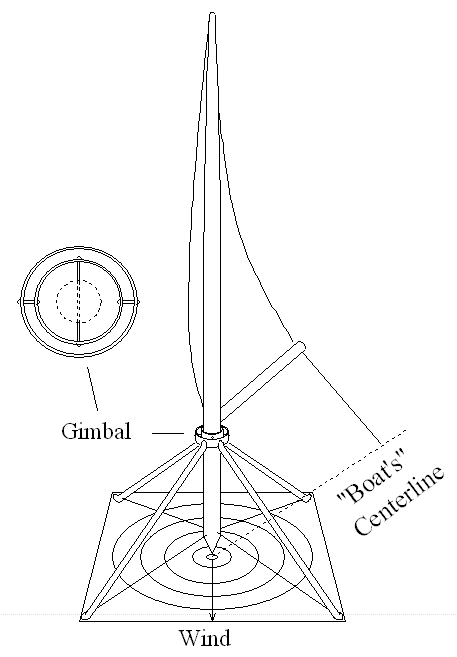Common Ground: A Proposal for Collective Design
This is an idea I’ve been kicking around for a while. I’ve come to realize that actual completion exceeds my interest. I think to m’self, “Why not tap into the collective experience of the community gathered around Duckworks Magazine?”
The goal is to be able to do the kind of rig comparison that requires access to a wind tunnel or to two or more identical hulls. The former is too expensive, and the latter, while loads o’ fun, requires help and introduces so many extraneous variables that results are debatable.
So. How about a contraption home-built to a standard plan which can mount scaled rigs and measure the angle and intensity of the thrust they generate?
It’s base is a half sheet of 3/4" ply (4ft x 4ft). From the corners are erected posts which converge on a simple gimbled mount. A mast of standard diameter is gimbaled with a fixed length extending below the pin. Four standardized shock absorbers center the base over a grid affixed to the base. The beast is fixed oriented to the wind (measured by an agreed on anemometer), and the rig is put through its paces, results being recorded on a standard form.

What results is a stream of data which, while ‘rough and ready’, would allow us to back up our pig-headed opinions with factoids. Categories of comparison aren’t necessarily limited to one. Rigs of a standard sail area would compare interestingly, as would rigs set on spars with a maximum length, as would sails of a given aspect ratio. A single sail form with roaches, hollows, draft amount and distribution, controls, envelopes, turbulence generators, etc., could be explored to the heart’s content!
I propose a forum to run for a set time for brainstorming and expert opinion gathering. That a ‘committee’ work up a first draft which is returned to forum for discussion. A final draft initiates the first real field test, with evaluation at the end of, say, a year. Further, a clearinghouse could be established to collect and publish results.
The base, stanchions and gimble all seem straightforward to me. What remain are the grid (probably a small area of concentric 1mm gradations, with angle reference lines overlaid?), categories and report formats, and suppliers of shock absorbers (shock cord, surgical tubing, springs or fish scales? ...something uniform, at any rate), wind direction (tell-tales at masthead? 10m into the wind?) and speed (Speedtech? Edmund Scientific? Radio Shack?). I’d think the whole thing could be built and equipped for less than $150, making it widely accessible.
Whuddaya say?
Dave Zeiger

